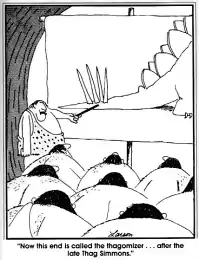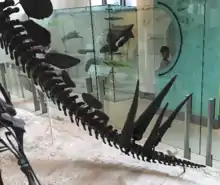Thagomizer
A thagomizer (/ˈθæɡəmaɪzər/) is a term coined 1982 by cartoonist Gary Larson in his comic The Far Side to refer to the tail spikes of stegosaurian dinosaurs. These spikes are believed to have been a defensive measure against predators.[1]

The arrangement of spikes originally had no distinct name; the term thagomizer was, and thereafter became gradually adopted as an informal term occasionally used within scientific circles, research, and education.


Mathematics

In a 2017 paper, the term thagomizer graph (and also the associated "thagomizer matroid") has been introduced for the complete tripartite graph K1,1,n.[2]
Etymology
The term thagomizer was coined by Gary Larson in jest. In a 1982 The Far Side comic, a group of cavemen in a faux-modern lecture hall are taught by their caveman professor that the spikes on a stegosaur's tail are so named "after the late Thag Simmons".[3]
The term was picked up initially by Ken Carpenter, a paleontologist at the Denver Museum of Nature and Science, who used the term when describing a fossil at the Society of Vertebrate Paleontology Annual Meeting in 1993.[4] Thagomizer has since been adopted as an informal anatomical term,[5] and is used by the Smithsonian Institution,[4][6] the Dinosaur National Monument, the book The Complete Dinosaur[7] and the BBC documentary series Planet Dinosaur.[8]
As stegosaurs and humans did not exist in the same era Gary Larson suggests in The Prehistory of the Far Side that "there should be cartoon confessionals where we could go and say things like, 'Father, I have sinned – I have drawn dinosaurs and hominids together in the same cartoon.'"[9]
See also
Other scientific terms first used in fiction:
References
- Holtz, T. R., (2000) "Classification and Evolution of the Dinosaur Groups" (pp. 140–168) in The Scientific American Book of Dinosaurs, edited by Gregory S. Paul, New York: St Martin's Press ISBN 0-312-26226-4.
- Gedeon, Katie; Proudfoot, Nicholas; Young, Benjamin (2017). "Kazhdan-Lusztig polynomials of matroids: a survey of results and conjectures" (PDF). Séminaire Lotharingien de Combinatoire. 78B: 80. arXiv:1611.07474.
- Black, Riley (March 30, 2011). "Watch Out For That Thagomizer!". Smithsonian.com. Retrieved May 28, 2019.
- "The word: Thagomizer". New Scientist. July 8, 2006. Archived from the original on September 30, 2007.
- Holtz, Thomas, R. Jr. (2007). Dinosaurs: the Most Complete, Up-To-Date Encyclopedia for Dinosaur Lovers of All Ages. New York: Random House. p. 230. ISBN 978-0-375-82419-7.
- "Stegosaurus Changes". Smithsonian National Museum of Natural History, Department of Paleobiology. Archived from the original on December 14, 2004. Retrieved March 3, 2007.
- Galton, Peter M. (1999). "Stegosaurs". In Farlow, James Orville; Brett-Surman, M. K. (eds.). The Complete Dinosaur. Indiana University Press. p. 302. ISBN 978-0253213136. Retrieved December 11, 2016.
In all stegosaurs, the terminal tail spines (thagomizer) presumably played a role in defense.
- "Fight For Life". Planet Dinosaur. Season 1. Episode 4. November 26, 2015. Event occurs at 9 minutes 14 seconds. BBC. BBC One. Retrieved December 11, 2016.
Stegosaurus: a heavily armored tank with a deadly weapon at the end of its tail, known as a thagomizer.
- Larson, G. (1992) The Prehistory of the Far Side p. 137. Warner Books.
